
Pressure vessels are containers that hold liquids or gases at a pressure that differs substantially from the outside pressure. Pressure vessels can be found in homes and industrial facilities all over the world. Some applications of pressure vessels include in steam boilers, engine cylinders and storing chemicals or petroleum products. These examples only begin to scratch the surface, as pressure vessels have nearly endless applications.While pressure vessels are extremely useful and likely will continue to be used indefinitely into the future, they can be problematic. The difference between the pressure inside a pressure vessel and the pressure outside makes for a potentially hazardous situation. Pressure vessels have long been known to be dangerous and have caused fatal accidents in the past. Because of this, the way pressure vessels are made and used is specified by engineering authorities, and these authorities are supported by governmental legislation.These standards also specify the need for testing and include guidelines for pressure vessel inspection procedures. The inspection of pressure vessels is both required and smart practice for anyone who wants to avoid an accident that could result in unplanned downtime, damaged equipment and potentially fatal injury to workers.In this article, we'll learn more about different types of pressure vessels, what pressure vessel inspections consist of and when they're required as well as different methods of testing.
Pressure vessels are designed differently based on their end application, though they all tend to look similar and include the same basic parts. Pressure vessels are typically cylindrical with rounded edges or are spherical. That's because these shapes avoid stress raisers.
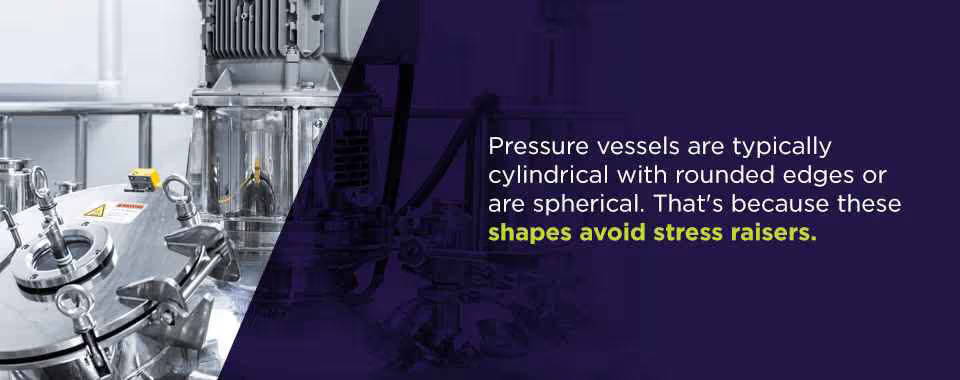
Common appendages include a pressure gauge, fusible plug and a differential pressure switch, which causes the compressor to come on when pressure drops and to turn off when pressure is at a max. Most pressure vessels are also equipped with a manhole, handhole or sight hole, which is for general cleaning and inspection. You may also find a condensate drain on the bottom of some pressure vessels. This feature either automatically drains or allows for manual draining of moisture. This is a helpful feature since, depending on the material, moisture in a tank can cause corrosion or pitting.Beyond their appearance, pressure vessels carry out different functions. One basic way of classifying pressure vessels is to divide them into two categories — fired and unfired, or non-fired. A typical example of a fired pressure vessel would be a boiler. Unfired pressure vessels are not connected with any steam generation or anything with a flame.We can further divide pressure vessels into a few different types. Though there are some outliers, the most common pressure vessels fall into three types — storage tanks, heat exchangers and process vessels. Let's look briefly at each type.
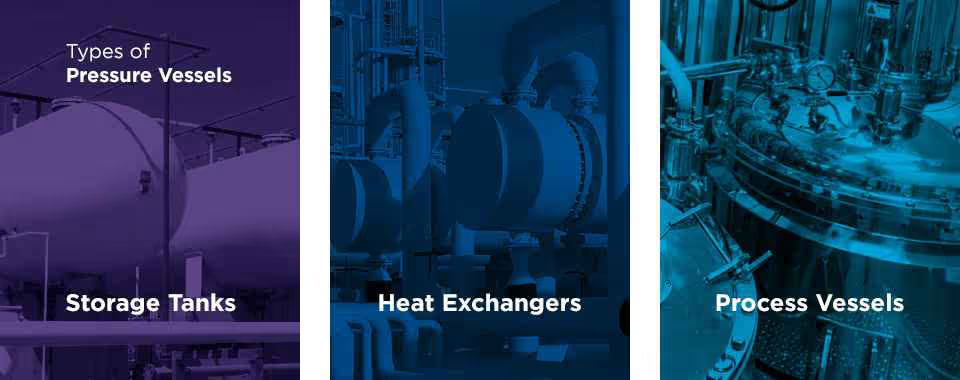
Storage tanks are the most common type of pressure vessel. They come in various shapes and sizes, but they are all designed to store liquids and gases under pressure. They might hold fuel oil, liquefied hydrogen or compressed natural gas or other materials that are valuable in industrial applications. These tanks are often made from carbon steel, though they may be coated in a different material on the inside. A typical residential example of a storage tank is a well pressure tank, which pressurizes water before it enters into a home's plumbing system.
After storage tanks, heat exchangers are the second most common type of pressure vessel. Heat exchangers transfer heat between mediums, often liquids. This way, heat exchangers are useful for both cooling and heating processes. Heat exchangers can be found in furnaces in homes all over, but they are also essential to processing and manufacturing plants. A common type of heat exchanger used in chemical processes is the shell and tube. With this type, within a pressurized shell, one liquid runs through tubes while the other liquid flows over the tubes, causing heat to transfer from one liquid to the other.
Process vessels, as the name suggests, are used to facilitate a process in a controlled environment. This process is typically one step in a more extensive process. This sub-process could involve combining materials, separating materials, agitating a mixture, breaking down products or removing an element from a product. Process vessels are designed and constructed with the specific process they're intended for in mind. Sub-types of process vessels include:
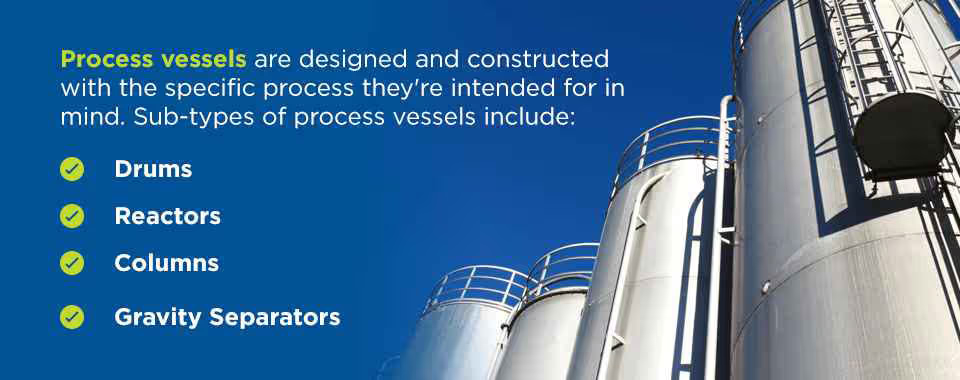
Pressure vessel inspection, or pressure vessel testing, involves non-destructive tests that ensure the integrity of a new pressure vessel or on previously installed pressure equipment that has been altered or repaired.In the early days of pressure vessels, many pressure vessels were over-pressurized, and they would explode. This problem was part of why the American Society of Mechanical Engineers (ASME) formed. This body came up with specifications to govern the way pressure vessels are manufactured and maintained. Today, the ASME is still responsible for establishing standards for pressure vessels in the U.S. Other countries have their own standards for pressure vessels.There are two standards that every manufacturer and user of pressure vessels should be aware of:
Certain industries and government agencies may have their own stringent standards that govern the requirements for pressure vessels. For example, NASA uses pressure vessels and systems to store gases and liquids that are used in launches and on-orbit operations. Once these vessels are in space, they usually can't be serviced, so it's crucial that they are rigorously examined before they leave Earth. Therefore, NASA has its own standards it abides by.Manufacturers should keep all the relevant standards in mind when designing and building pressure vessels. However, just attempting to follow the standards isn't enough. There needs to be a way of confirming that every pressure vessel that enters the market is safe. This is where pressure vessel inspection comes in. There are various tests a professional can employ to make sure a pressure vessel meets the necessary pressure vessel testing requirements and is ready to be used. For example, the inspector must check that the vessel's shell is thick enough to keep the pressure in.After a pressure vessel moves from its initial manufacturing and testing to its end application, it may undergo alterations or repairs. Whenever something like this happens, the pressure vessel needs to be inspected again to see whether it still meets all requirements.

While the two scenarios above are times when pressure vessel inspections are required, a vessel could experience issues over time that could cause it to break down and no longer be safe, especially if it is not properly maintained. Here, again, pressure vessel inspection plays an important role. An inspector can periodically check to ensure that a pressure vessel is in good working order and does not pose a threat.If there are any issues that could lead to more serious problems, an inspector can point these out so the necessary maintenance is carried out. This can prevent a pressure vessel from failing and causing severe injury to workers and damage to a manufacturing plant or other type of facility.
Pressure vessels need to be structurally sound to maintain their internal pressure and not to allow whatever material is contained inside to leak out. Testing is intended to ensure that pressure vessels don't contain any flaws like punctures, cracks or loose connections that could compromise their efficacy.
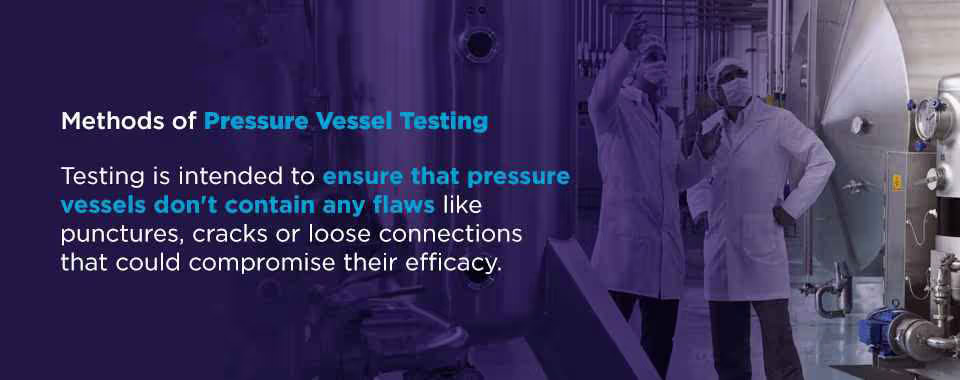
Two primary types of tests that are performed on pressure vessels include hydrostatic and pneumatic tests. The key difference between these two types is that hydrostatic testing uses water as the test medium, and pneumatic testing uses a non-flammable, non-toxic gas like air or nitrogen.A concern with pneumatic testing is that, if a fracture occurs during testing for some reason, it could lead to an explosion. This makes hydrostatic testing a safer option since the volume of water does not rapidly increase when it is suddenly depressurized. However, there are situations where pneumatic testing is a viable option.Hydrostatic testing involves filling a vessel entirely with water, pressurizing it up to one and a half times its design pressure limit and then watching for any leakage. Adding a tracer or a fluorescent dye to the water inside can make it even easier to see where there may be leaks. Hydrostatic testing could cause damage to a pressure vessel if the water is pressurized too much or if the pressure causes a small fracture to spread rapidly.Beyond these basic types of testing, OSHA identifies five non-destructive testing (NDT), also called non-destructive examination (NDE), methods that are widely used on pressure vessels:
One type of testing is a visual inspection, which can give a good overview of a vessel's general condition. First making sure the surface of a vessel is clean and well-lit, pressure vessel inspectors will examine any part of the vessel they can observe. They will look at things like any welded seams, such as those around appendages or along the length of the vessel's shell.They may see that the vessel appears to be in good working condition, or they may observe issues like cracking, corrosion, erosion or hydrogen blistering. While a visual inspection can reveal some problems, it can only take you so far. Some other non-destructive testing methods can further reveal whether a pressure vessel's construction and function are sound.
A liquid penetrant test is a means of checking for flaws on a pressure vessel that are open to the surface. First, an inspector flows a very thin liquid, known as a penetrant, into the possible flaw. Typically, the penetrant is sprayed on and allowed time to soak in. A tester can add a fluorescent chemical to the penetrant so that it will be even more visible under ultraviolet light.
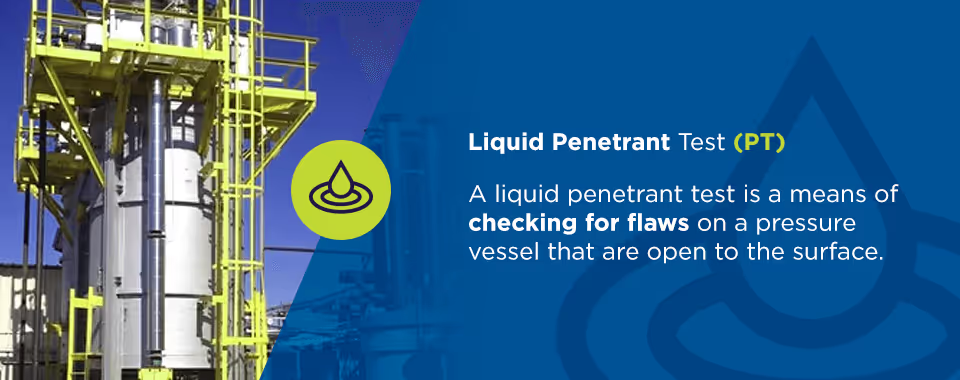
After letting the penetrant dry, the inspector then wipes off the penetrant left on the surface and uses a developer to draw out any penetrant that has seeped into cracks. As the penetrant comes up to the surface, it reveals the magnitude of the problem. This method of testing is most often used on welded seams, but it can also be used on bars, plates, pipes and more.
In a magnetic particle test, the inspector runs a magnetic current through the pressure vessel, typically using the prod method, where an electric current flows between contact probes. If there are any defects in the shell's material, a "flux leakage field" will appear. In other words, these defects will interrupt the flow of the magnetic current, causing magnetism to spread out from them.The flux leakage fields become visible when the inspector spreads ferromagnetic particles on the vessel. In a wet magnetic particle test, these particles consist of a wet suspension in a liquid, and in a dry magnetic particle test, they consist of a dry powder. As with the liquid penetrant test, the particles can be treated, so they fluoresce under black light. As the metal particles are attracted to the magnetic current, they reveal the approximate dimensions of any flaws that have created flux leakage fields.
Unlike the previous three methods, radiography can detect more than flaws that are near or on the surface — it is a volumetric method, meaning it can detect issues inside the vessel.Radiography uses gamma or X-rays to produce a picture of the vessel. Just as with medical radiography, holes, discontinuities and other differences in density decrease the attenuation of the X-ray, leading to greater exposure on the film. On the negative film, these more exposed areas appear darker. Open voids will appear pretty obvious in a radiographic image, but more minor cracks can be elusive.
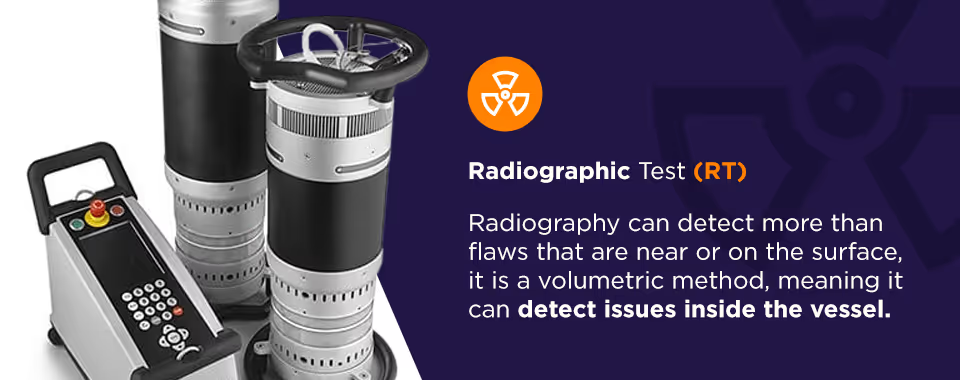
Ionizing radiation can be dangerous, so these tests should only be conducted by an experienced professional. An inspector must also be experienced to accurately interpret the image that is produced and correctly identify if and where there are any defects in the pressure vessel.
Ultrasonic testing is another volumetric method. It uses sound waves to measure a material's thickness or detect any defects. An electronic system produces high-voltage electrical pulses, and in return, a transducer creates high-frequency ultrasonic energy. As the ultrasonic sound waves move through the material, if they encounter a discontinuity, the discontinuity will reflect back some of the energy. The transducer converts this reflected wave into an electrical signal, which is then shown on a display.Generally speaking, ultrasonic testing must be read in real-time since it doesn't produce a lasting record like radiography does. However, some modern UT equipment is designed with a means of recording the signals.
Pressure vessel testing, as we've seen, is required at certain stages, but it's also something all manufacturers and end users should want to prioritize since it's so critical to maintaining their operations and people's safety. If a pressure vessel holds a poisonous gas, a rupture could allow for a dangerous gas leak. Even if the material inside isn't poisonous, a ruptured vessel could lead to an explosion or a serious fire.An event like this could quickly bring your operations to a halt. Consider what operations in your business are, in some way, dependent on a pressure vessel. Now imagine those operations ceasing until the pressure vessel is replaced. Unplanned downtime can result in a great financial loss.An accident from a pressure vessel could also severely damage equipment within the vicinity of the pressure vessel. It could cost hundreds, thousands or even millions of dollars to replace the damaged equipment. And, of course, any equipment out of commission will add to the issue of unplanned downtime.An even graver consequence than financial loss is if any workers are poisoned or caught up in an explosion or fire. Employers are responsible for maintaining a safe working environment for their workers, and an injury or death due to a faulty pressure vessel can seriously compromise this environment.
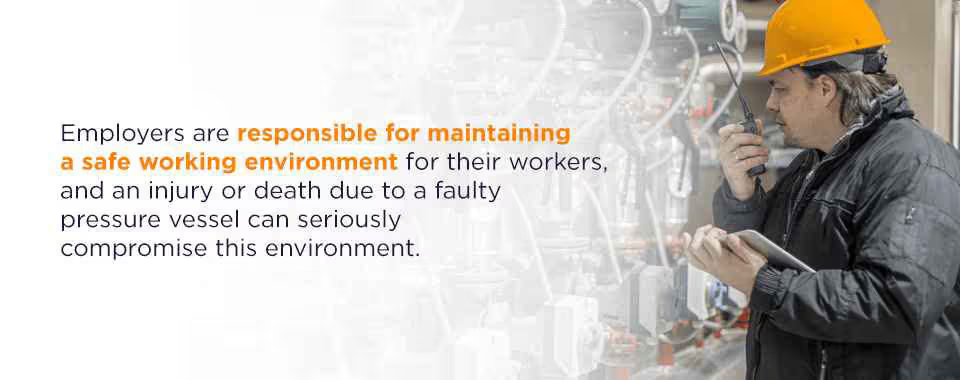
None of this will seem important if you assume your pressure vessels are in good shape. While this is hopefully the case, you cannot know for sure unless your vessels are tested. The results of a pressure vessel inspect may surprise you. According to OSHA, recent pressure vessel inspections have revealed the fact that many pressure vessels in workplaces are cracked or damaged.Regular inspections can make all the difference in preventing a dangerous failure. Pressure vessel inspection frequency depends on a variety of factors, but a general rule of thumb is that you should have your pressure vessel inspected every five years. These inspections should be thorough and involve a visual inspection, a hydrostatic pressure test, a thickness evaluation, a stress analysis and an inspection of any pressure release valves.
Whether you're a manufacturer of pressure vessels or an end user who depends on storage tanks, heat exchangers or process vessels for your operations, consider partnering with NTS for pressure vessel inspection services. NTS is a private test, inspection and certification company with a longstanding reputation for excellence. For more than 50 years, we have acquired the expertise and physical capabilities to offer an impressively wide range of engineering services. We have partnered with the defense, aerospace and automotive industries, just to name a few.We have an ever-expanding network of laboratories and certification houses across the U.S. We work with your engineering team to make sure we meet your needs and provide any necessary solutions. If you're looking to get a pressure vessel to market and want to avoid delays, our team can help you make sure your product meets all standards for safety and quality promptly.For example, we can conduct pneumatics testing safely and efficiently in a controlled environment. Our NTS Santa Clarita location, which is accredited like all of our testing facilities, is home to our largest pneumatics test capabilities. Here, we can test factors like air flow, management subsystems for pressure and temperature, as well as compressed air components. We can also test countless other aspects of your products, including factors like structural stress, external thermal control and vibration.

No matter what your inspection and testing needs are, NTS is here to offer an effective solution. As one of the most well-known and well-respected testing companies in North America, NTS is a trustworthy partner who can help you meet your goals. Contact us to request a free quote or simply to learn more about what we can do to serve you.